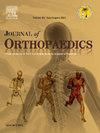膝关节天然冠状面排列(CPAK)改变对患者报告的结果测量(PROMS)的影响。双侧单种植体研究。
IF 1.5
Q3 ORTHOPEDICS
引用次数: 0
摘要
背景:当代趋势倾向于限制运动对齐(rKA)策略,结合安全边界来恢复患者自然对齐的可变百分比。本研究的目的是比较双侧全膝关节置换术患者术前和术后冠状面膝关节对齐(CPAK)与SAIPH (MatOrtho, UK)。其概念是控制种植体(两侧相同的假体)和患者(双侧模型),并评估任何手术对齐改变对患者结果的影响,通过患者报告的结果测量(PROMS)和患者满意度来测量。方法:本研究纳入2012年至2022年间接受双侧序贯全膝关节置换术并植入SAIPH假体的70例患者和140个膝关节。获得PROMS、临床评价、术前、术后CT平片及x线平片。测量CPAK表型、股骨外侧远端角、胫骨内侧近端角、关节线倾角(JLO)和算术髋关节-膝关节-踝关节角(aHKA)。结果:术后CPAK表型恢复率为27.9%,未恢复率为72.1%。未重建CPAK表型时,PROMS无显著差异。此外,aHKA或JLO的单独改变对结果没有显著影响,重建原始冠状排列的TKA也不太可能成为患者首选的侧位。结论:针对个体患者特征的调整方法可能对最佳功能结果至关重要,但在本研究中,当使用PROMS作为结果测量时,我们无法显示在TKA后重建CPAK的患者与未重建原生CPAK的患者之间存在差异。本文章由计算机程序翻译,如有差异,请以英文原文为准。
Impact of changes in native coronal plane alignment of the knee (CPAK) on patient-reported outcome measures (PROMS). A bilateral single implant study
Background
A contemporary trend favours a restricted kinematic alignment (rKA) strategy, incorporating safe boundaries to restore a variable percentage of a patient's natural alignment.
This study aims to compare preoperative and postoperative coronal plane knee alignment (CPAK) in patients undergoing bilateral TKA with SAIPH implants (MatOrtho, UK). The concept was to control the implant (same prosthesis both sides), patient (bilateral model) and assess what effect any surgical alteration in alignment had on patient's outcomes measured by patient-reported outcome measures (PROMS) and patient satisfaction.
Method
A total of 70 patients and 140 knees who underwent bilateral sequential TKA with a SAIPH implant between 2012 and 2022 were included in this study. PROMS, clinical assessment, pre and postoperative CT scans and plain x-rays were obtained. The CPAK phenotype, lateral distal femoral angle, medial proximal tibial angle, joint line obliquity (JLO), and arithmetic Hip-Knee-Ankle (aHKA) angle were measured pre and postoperatively.
Results
Postoperative CPAK phenotype recreation was achieved in 27.9 %, while in 72.1 % it was not. PROMS did not significantly differ when CPAK phenotype was not recreated. Additionally, isolated changes to aHKA or JLO did not significantly impact outcomes, nor was a TKA that recreated the native coronal alignment more likely to be the patient's preferred side.
Conclusion
Tailoring alignment approaches to individual patient characteristics may be crucial for optimal functional outcomes but in this study, we were not able to show a difference between those with CPAK recreated versus those who did not have native CPAK recreated following TKA when using PROMS as the outcome measure.
求助全文
通过发布文献求助,成功后即可免费获取论文全文。
去求助
来源期刊

Journal of orthopaedics
ORTHOPEDICS-
CiteScore
3.50
自引率
6.70%
发文量
202
审稿时长
56 days
期刊介绍:
Journal of Orthopaedics aims to be a leading journal in orthopaedics and contribute towards the improvement of quality of orthopedic health care. The journal publishes original research work and review articles related to different aspects of orthopaedics including Arthroplasty, Arthroscopy, Sports Medicine, Trauma, Spine and Spinal deformities, Pediatric orthopaedics, limb reconstruction procedures, hand surgery, and orthopaedic oncology. It also publishes articles on continuing education, health-related information, case reports and letters to the editor. It is requested to note that the journal has an international readership and all submissions should be aimed at specifying something about the setting in which the work was conducted. Authors must also provide any specific reasons for the research and also provide an elaborate description of the results.
 求助内容:
求助内容: 应助结果提醒方式:
应助结果提醒方式:


